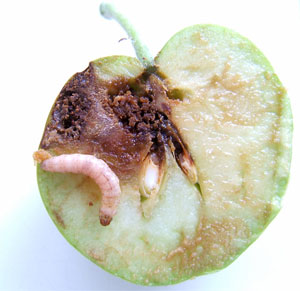The Parade of Worms…CM Emergence Continues, OBLR and ECB Flight Underway. Larval Hatch Expected

Alert: Codling moth emergence continues, OBLR and ECB Flight Underway with larval hatch of these three pests present over the next few weeks.
* Codling Moth: With the significant rain we received over the past 7-days apple growers will need to recover blocks to maintain residual control of the first generation Codling Moth.(Codling moth materials below).
* Oblquebanded Leafroler: We’ve been capturing OBLR adult male moths since May 30th and are confident of our sustained flight over the following days. Using the 30th as our biofix, the NEWA model calculates the early period of emergence for the 17th of June. If you found OBLR in your traps prior to or after our trap findings you should use the NEWA site to fine tune your application window.
* European corn borer (ECB) z-strain adult have been captured in pheromone traps in Florida, NY (Orange County) with 700 DD50 accumulated this season. Application timing for ECB should occur prior to egg hatch. Modeling predictions for hatch traditionally has used 800DD50 in sweet corn production for the initial management timing of young larva. With increasing temperatures we will likely achieve the 800DD50 by the 15-16th of June.

1st generation codling moth larva and fruit injury with seed feeding.
To maintain a resistance management program for this pest you should use the same product you applied during the first application. As the insect has two to three generations each season, the rotation of insecticide should be for the next generation using a different active ingredient, indicated by a different IRAC number.
Focused attention on the first generation can significantly reduce the endemic CM population in your orchard. Once in orchard populations establish, the likelihood of resistance increases. If persistent CM damage occurs yearly at packout, then addressing this first generation is critical to address concerns over achieving excellent coverage, proper timing and employment of the most efficacious materials and effective rates. Scouting of 1000 fruit per block is a quick way to determine in season efficacy while addressing shortcomings of your management program at the end of each generation. For 1st generation this will be in early July.

OBLR Summer larvae, webbing and feeding.
Oblquebanded Leafroler: has been a long standing apple pest in the Hudson Valley. Good control has been achieved using new reduced risk materials in combination with insect predictive modeling for management decision making at early hatch. We’ve been capturing OBLR adult male moths since May 30th and are confident of our sustained flight over the following days. Using the 30th as our biofix, the NEWA model calculates the early period of emergence for the 17th of June. If you found OBLR in your traps prior to or after our trap findings you should use the NEWA site to fine tune your application window. OBLR Fact Sheet.

ECB Frass, Infestation of Young Apple
European corn borer (ECB) is traditionally considered to be a pest of sweet and field corn. Young trees are often left with little consideration for pest management. The ECB can easily infest newly planted blocks to cause extensive damage to the terminal shoot, boring into and killing the central leader. This will then require additional labor to prune out the dead wood, select a new terminal, secure and tying it to bamboo or wire for establishment. Management of the ECB will begin soon and growers should monitor young plantings for frass and tunneling over the next few weeks.
The z-strain adult have been captured in pheromone traps in Florida, NY (Orange County) with 689 DD50 accumulated this season. Application timing for ECB should occur prior to egg hatch. Modeling predictions for hatch traditionally has used 800DD50 in sweet corn production for the initial management timing of young larva.
For 1-3 year and newly planted apple ECB will lay eggs on terminal shoot growth. Emerging larva will bore into the central leader stem, killing off the growing aprical shoot. This produces multiple shoot development, requiring central leader shoot selection to restart the central leader. Needless to say, the new tree looses terminal extension growth and reduces early production, essential for new plantings to establish early yields for optimum profitability. Modeling predictions for hatch traditionally has used 800DD50 in sweet corn production for the initial management timing of young larva. With increasing temperatures we will likely achieve the 800DD50 by the 15-16th of June.
Most insecticides used to manage Codling Moth (CM) and Obliquebanded Leafroller (OBLR) will also control ECB. Below are the CALS Guidelines for ECB management.

Cornell Guidelines for CM Mgt.

CALS Guidelnes: OBLR 1st summer gen.

CALS Guidelines ECB 1st summer gen.